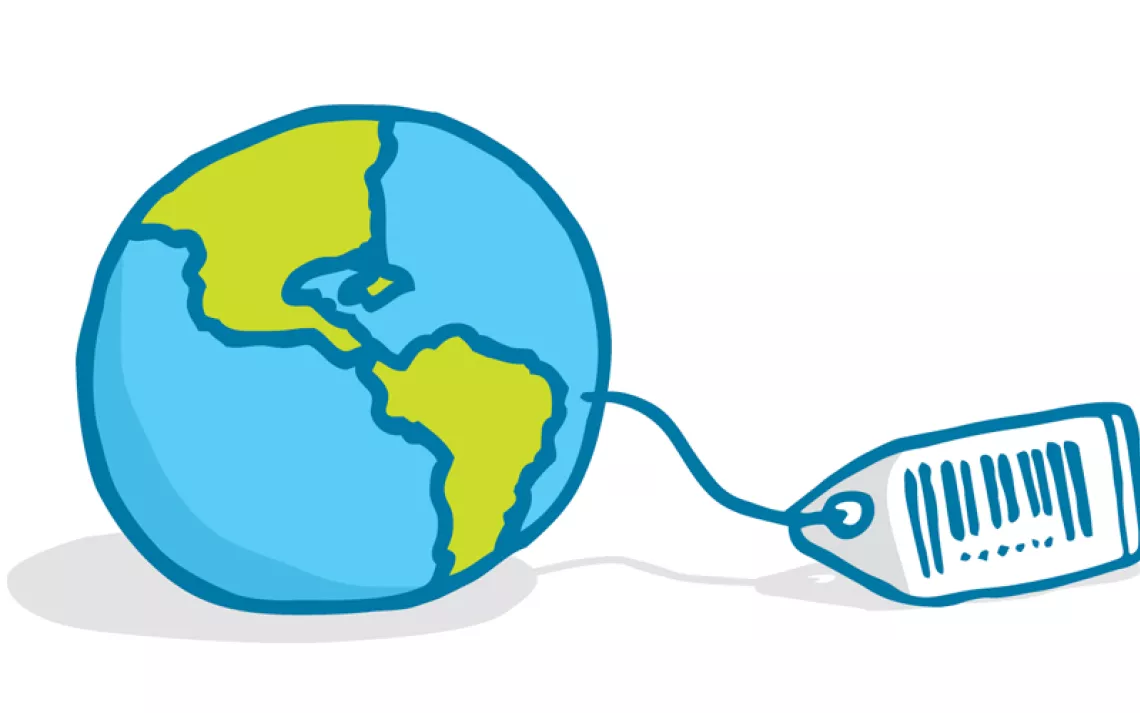8 Ways to Green Your Laundry Routine
Tips to spare your clothes, your wallet, and the planet

Photo by totalpics/istock
The planet might dread laundry days as much as we do. From the tiny plastic particles shed by our polyester clothes to the gobs of water and energy consumed with each wash, our laundry habits add up to some surprising environmental costs. Luckily, greening your laundry routine can be relatively pain-free, and it’s an impactful way to curb your personal environmental footprint. Here are a range of tips, most ultra-convenient, that will not only save you money and spare the earth but also keep your clothes looking better longer.
1. Switch Every Load to Cold
“The simplest and easiest thing to do with no sacrifice at all is to always use cold water wash,” says Noah Horowitz, senior scientist at the Natural Resources Defense Council. Most of us have heard this advice, but we still cling to the notion that hot water equals clean. A recent survey by the American Cleaning Institute shows that only half of Americans wash their clothes in cold water most of the time. The fact is that modern machines and soaps are designed to work best in cooler temps for all but the dirtiest loads. And turning the dial down adds up to huge environmental savings: As much as 90 percent of the energy consumed by our washing machines goes to heating the water. If you simply must use heat, the NRDC says that even turning the dial down to warm can cut the energy use in half.
Of course, you should take exception to this rule if someone in your family is ill with a contagious illness or if your clothes have come into contact with a potentially contaminated surface. In this case, it’s important to wash your clothes on the hottest setting and to dry them on high heat for up to 45 minutes to kill any traces of the virus, says Dr. Carol DerSarkissian, an emergency room physician and WebMD’s medical reviewer for hygienic laundry techniques. To curb your laundry’s energy impact in these situations, wear clothes that can withstand high heat washes (like cotton). And, keep a separate set of outdoor clothes, advises DerSarkissian. "And then wash those outside clothes on high heat." Everything else can be washed as normal.
2. Tweak Your Settings
Another simple piece of advice is to take the time to put your machine on the right settings. “How you use your device really dictates what your environmental impact is,” says Horowitz. For example, make sure you select the right load size, so the machine doesn’t use too much water. On your dryer, always use the presets like Normal or Standard, as they engage the machine’s sensors to automatically shut off once the clothes are dry. Choosing a drying time yourself often leads to more energy consumption, by comparison. “You might be cooking your clothes, but you're also wasting energy and time by having that thing running when it doesn't need to,” he adds.
3. Save the Oceans From Shedding
Plastic pollution is a major crisis—and, surprisingly, as much as a third of the microplastics in our oceans are coming from our clothes. “What we wear contains more and more polyester, spandex, nylon, and other materials that are basically plastic,” explains Dimitri Deheyn, a microfiber researcher at the Scripps Institution of Oceanography at UC San Diego. Deheyn says that while plastic clothes shed fibers even while we’re walking around, it’s the mechanical agitation of our washing machines (and some studies show the exposure to water) that causes fabrics to degrade the most, and these fibers escape wastewater treatment plants and can flow out to sea.
To slow the shedding, Deheyn recommends air drying synthetic clothing (“They are made to dry fast anyway,” he says). You can also purchase a microfiber capture laundry bag, like Guppy Friend ($29.75), or the Cora Ball ($37.99), which can be tossed into the machine and catches some fibers. Or, consider adding a microfiber filter to your washing machine. Planet Care sells one ($102) as does Lint LUV-R ($140), and Girlfriend, a clothing brand, does too ($45). A California bill aims to require public utilities and machine manufacturers to install microfiber filters, but Deheyn says that consumers should take action to reduce the problem now.
4. Dry Longer and Lower
There is no way around it, tumble dryers are unrelenting energy hogs. Americans use large high-heat dryers that are difficult to make more efficient. “The average household uses roughly three times more energy each year to dry their clothes than to wash them,” says Horowitz, with some machines gobbling up as much energy as a refrigerator, dishwasher, and clothes washer combined.
There are a few ways to use your machine a little more efficiently, says Horowitz, including cleaning your lint trap after every load as well as using longer drying times on the lowest heat setting. “You're using less energy because you're not having to get the air temperature as high.” The one exception to this advice is if someone in your family is ill or your clothes have come into contact with contaminated surfaces. In that case, dry your clothes on high heat, says Dr. DerSarkissian.
You can also use the maximum spin cycle on your washer to ring out your clothes before drying them, so your dryer doesn’t have to work as hard. And if you’re shopping for a new machine, look for a heat-pump model, which uses 20 to 50 percent less energy, says Horowitz, or a hybrid machine that has a heat-pump setting (keep in mind, they take longer to dry).
5. Air Dry More (Yes, It Can Be Convenient)
Air drying is the much greener option. Whether you’re trying to prevent microfiber pollution or quit your tumble dryer, air drying isn’t just better for the environment; it’s better for your clothes. Studies show that high heat from a clothes dryer not only fades fabrics but breaks them down. That lint is your clothing falling apart.
Air drying doesn’t have to be cumbersome. If you can do it outside, that's all the better since sunlight's UV rays kill bacteria and viruses, says Dr. DerSarkissian. But if you don’t have space for a clothesline, you can purchase an indoor clothes-drying rack. Most can be folded down and discreetly stored. Or, drape items over a towel rack or shower rod. Another trick is to hand wash small loads of socks, underwear, and gym clothes throughout the week and air dry them; this is a great way to skip big laundry days, saving yourself time. And remember there’s no pressure to air dry everything. Every minute the dryer isn’t running is money and energy saved.
6. Choose Safer Suds
Of the over 1,300 laundry detergents and products studied and ranked by the Environmental Working Group, a nonprofit working to eliminate toxicity in consumer products, a whopping 68 percent receive a failing grade, meaning we’re washing our clothes in chemicals that are harmful to human health or the environment. Thankfully, it’s easy to make a switch to a safer, greener detergent using the group’s online Guide to Healthy Cleaning (Ecover, Whole Foods 365 Everyday Value, Dr. Bronner’s, and Seventh Generation are some of the well-known brands that earn top grades). Or, look for the EPA’s green and blue Safer Choice logo when you’re out shopping, which indicates products made with the safest ingredients.
Keep in mind that fabric softeners, stain removers, dryer sheets, and other laundry “add-ons” are more likely to have hazards lurking in them, and are more difficult to find safe alternatives for. One tip is to buy reusable wool dryer balls; they are nontoxic and cut down on drying time. And household ingredients like hydrogen peroxide, lemon juice, rubbing alcohol, and clear dish soap work great on stains as long as you treat the garment immediately.
7. Beware the “Green” Dry Cleaner
Watch out for toxic chemicals at your local dry cleaner. The most common dry-cleaning solvent, called perchloroethylene, is a known carcinogen and a potential soil and groundwater contaminate, says Steve Whittaker, a dry-cleaning solvent expert and the program manager at Seattle’s Hazardous Waste Management Program. Thankfully, more dry cleaners are switching to alternatives. Solvents called “high flashpoint hydrocarbons” are safer than perchloroethylene, says Whittaker. Professional wet cleaning, which uses nontoxic soap and water in industrial machines is the greenest and safest route (but it’s also far less common). Dry cleaners may advertise themselves as “organic” or “green,” but Whittaker warns that the industry is rife with greenwashing. “That is why it is so important to ask the shop owner directly about which solvent they are using,” he says. One last tip: Many garments labeled Dry Clean Only, like your silk tops and cashmere and wool sweaters, can be hand washed at home. Suits, another commonly dry cleaned item, can be worn many times without being cleaned.
8. Wear More, Wash Less
It may sound unsavory to wash your clothes less frequently, but in reality, most Americans over-wash their clothes (the fact that we do 300 loads of laundry per year is a sign we’re fanatical about it). And, unless someone has a contagious illness in your household, there’s no evidence that skipping washes is bad for health or hygiene. We’re using our machines to freshen garments rather than to truly clean them. Undergarments, socks, and gym clothes should be washed regularly. And synthetics like polyester and nylon will need to be washed more frequently than natural fibers, because they trap odors. But for most garments that are worn but not dirty (your nose is your best guide), hang them up and air them out overnight. Use a lint brush or a fabric steamer to freshen and sanitize clothes before wearing them again. “Every drop of water we don't need to use, we're better off. You'll have a lower water bill too,” says Horowitz. And imagine how many laundry days you could forgo by simply rewearing your clothes.
This article has been updated since publication.
 The Magazine of The Sierra Club
The Magazine of The Sierra Club



